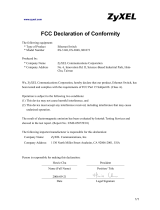
Table of Contents
GS1100 Series User’s Guide
5
Table of Contents
Part I: User’s Guide............................................................................................7
Chapter 1
Getting to Know Your Switch ..............................................................................................................8
1.1 Introduction ....................................................................................................................................... 8
1.2 Features ............................................................................................................................................. 9
1.3 Example Applications ...................................................................................................................... 9
1.3.1 PoE Example Application ....................................................................................................... 9
1.3.2 Backbone Example Application ......................................................................................... 10
1.3.3 Bridging or Fiber Uplink Example Application .................................................................... 10
Chapter 2
Hardware Installation and Connection ...........................................................................................12
2.1 Installation Scenarios ...................................................................................................................... 12
2.1.1 Before Using the Switch ........................................................................................................ 12
2.2 Hardware Installation ..................................................................................................................... 12
2.3 Desktop Installation Procedure ..................................................................................................... 13
2.4 Wall Mounting ................................................................................................................................. 14
2.4.1 Installation Requirements ..................................................................................................... 14
2.5 Rack Mounting ................................................................................................................................ 16
2.5.1 Installation Requirements ..................................................................................................... 16
2.5.2 Precautions ............................................................................................................................ 17
2.5.3 Attaching the Mounting Brackets to the Switch ............................................................... 17
2.5.4 Mounting the Switch on a Rack .......................................................................................... 17
Chapter 3
Hardware Panels................................................................................................................................19
3.1 Front Panel ...................................................................................................................................... 19
3.1.1 RJ-45 Auto-negotiating Ports ............................................................................................... 20
3.1.2 IEEE 802.3az EEE ..................................................................................................................... 20
3.1.3 Gigabit Ethernet Ports ........................................................................................................... 20
3.1.4 PoE (GS1100-10HP) ................................................................................................................ 21
3.1.5 SFP Slots (GS1100-24 and GS1100-10HP) ............................................................................. 21
3.2 Rear Panel ....................................................................................................................................... 23
3.2.1 Grounding (GS1100-10HP) ................................................................................................... 24
3.2.2 Power Connection ................................................................................................................ 26
3.2.3 LEDs ......................................................................................................................................... 26




















